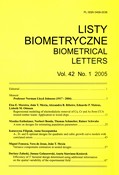
Listy Biometryczne - Biometrical Letters vol. 42(1), 2005, pp. 11-23


|
REGRESSIONAL MODELING OF ELECTRODIALYTIC REMOVAL OF CU, CR AND AS FROM CCA TREATED TIMBER WASTE: APPLICATION TO WOOD CHIPS
Elsa E. Moreira, Joao T. Mexia1, Alexandra B. Ribeiro, Eduardo P. Mateus2, Lisbeth M. Ottosen3 1Departament of Mathematics, Faculty of Science and Technology, New University of Lisbon, Monte da Caparica 2829-516 Caparica, Portugal e-mail: elsa.moreira@oninetspeed.pt, jtm@fct.unl.pt 2Departamento Ciencias e Engenharia do Ambiente, Faculdade de Ciencias e Tecnologia, Universidade Nova de Lisboa, 2829-516 Caparica, Portugal e-mail: abr@fct.unl.pt 3Department of Civil Engineering, Technical University of Denmark, 2800 Lyngby, Denmark e-mail: lo@byg.dtu.dk |

The volume of waste wood treated with chromated copper arsenate (CCA) is expected to increase over the next few decades. Therefore, alternative disposal options to landfilling are becoming attractive, especially those that promote re-use. The authors modeled the electrodialytic removal of Cu, Cr and As from CCA-treated timber waste. The method uses a low-level direct current as the "cleaning agent", in the presence of an extracting solution. The technique was tested in thirteen experiments on wood chips of out-of-service CCA-treated Pinus pinaster Ait. poles. The experiments differ in the extracting solution and initial current intensity, which may be considered as different treatments. Statistical techniques were used to compare the results of the different treatments, in order to select the best conditions for overall removal of the three metals. First, the five best treatments were selected, on the basis of the efficiency of removal of Cu, Cr and As. Then a multi-treatment regression approach was applied to the selected treatments, which points to the choice of oxalic acid with a concentration of 2.5%.

CCA treated timber waste, Electrodialytic remediation, Wood chips, Copper, Chromium, Arsenic, Regressional modeling, Multi-treatment regression design.
